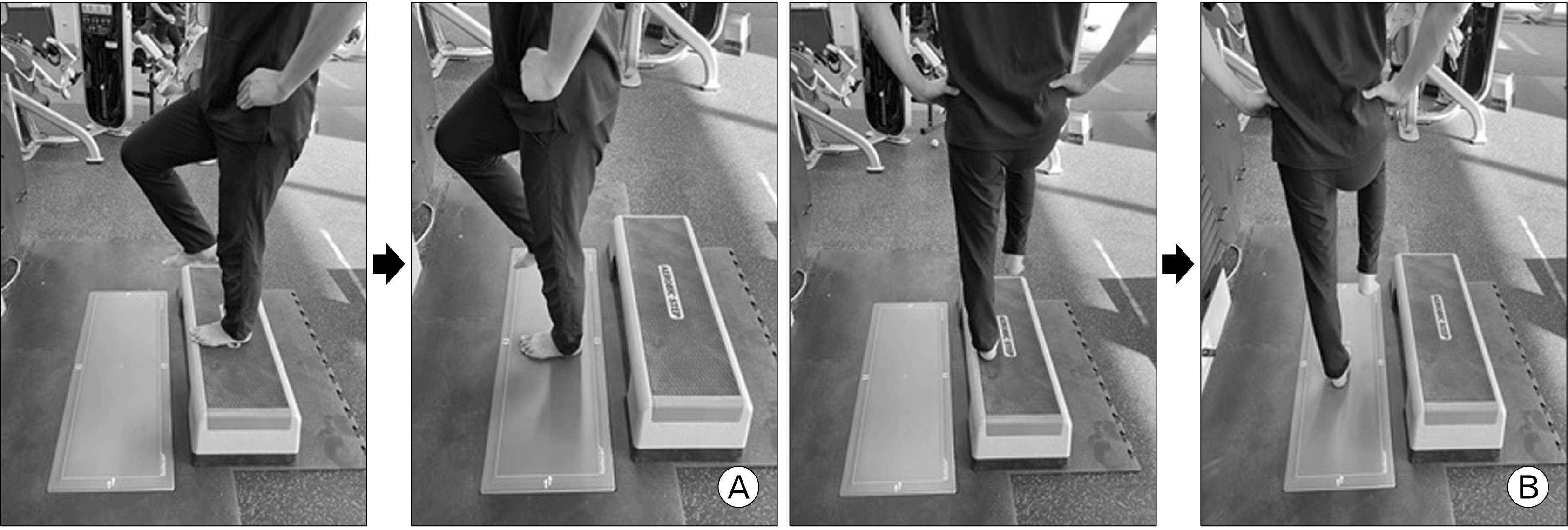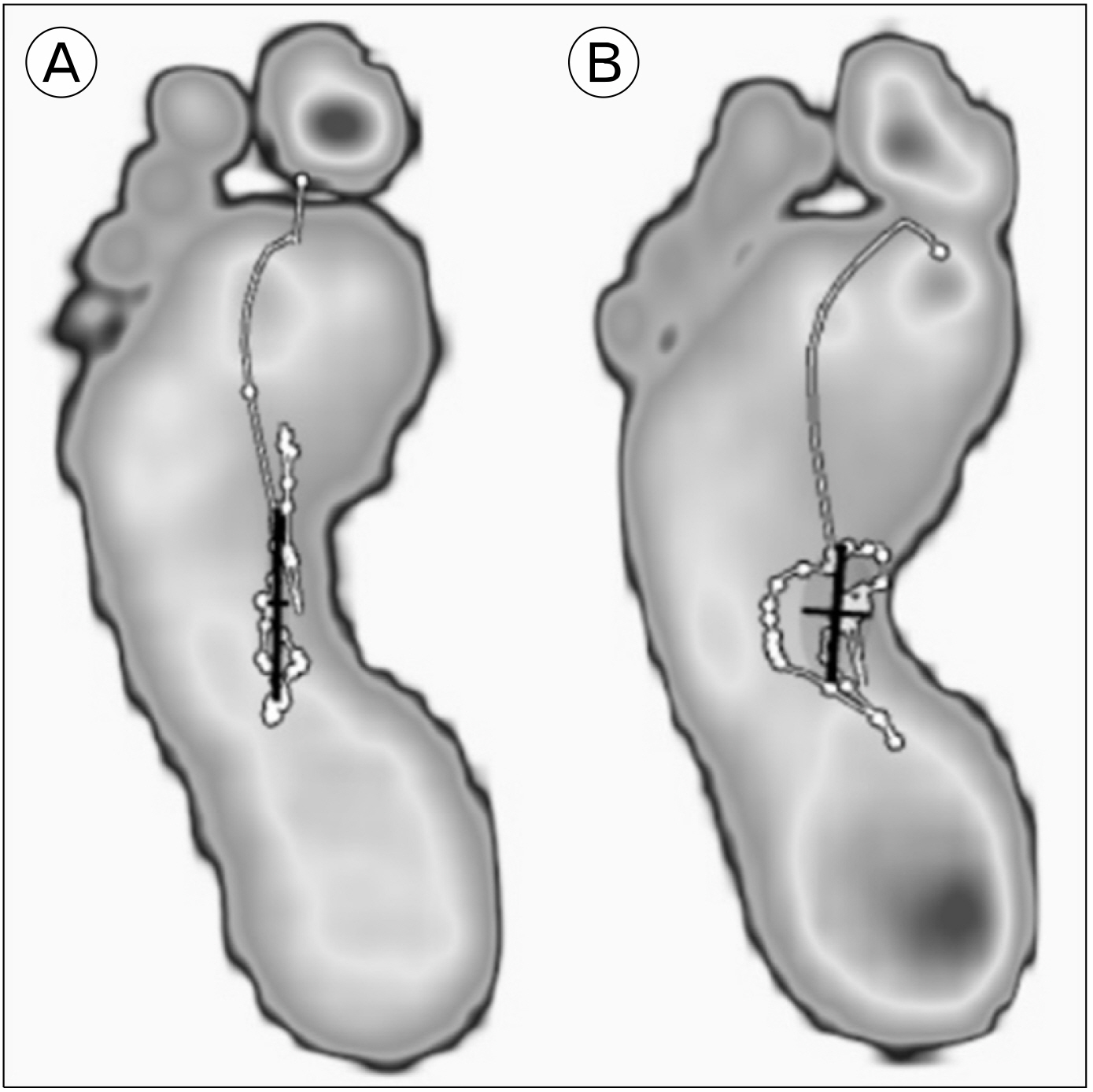Korean J Sports Med.
2022 Dec;40(4):217-225. 10.5763/kjsm.2022.40.4.217.
Functional Evaluation Using Center of Pressure between Chronic Ankle Instability and Healthy Control
- Affiliations
-
- 1Department of Physical Education, Yonsei University, Seoul, Korea
- 2Seojong Sports Medicine & Performance Center, Seoul, Korea
- 3International Olympic Committee Research Centre Korea, Seoul, Korea
- 4Department of Sports Medicine, Dongguk University, Wise Campus, Gyeongju, Korea
- 5Institute of Convergence Science, Yonsei University, Seoul, Korea
- KMID: 2536672
- DOI: http://doi.org/10.5763/kjsm.2022.40.4.217
Abstract
- Purpose
Mechanical and functional ankle instability or combinations of both can contribute to chronic ankle instability (CAI). Therefore, the purpose of this study was to compare the difference in (1) static and (2) dynamic balance function between patients with CAI and the controls; (3) to investigate association between balance function and CAI; and (4) to examine whether balance assessments are valuable for diagnosing CAI.
Methods
This study was conducted on 40 patients with CAI and 40 ankle healthy individuals. All participants evaluated the Cumberland Ankle Instability Tool questionnaire. Additionally, joint laxity and center of pressure (COP) during static postural control, anterior landing, and lateral landing were measured using an electronic pedobarography.
Results
CAI patients showed a larger COP area than controls when performing static postural control (p=0.023) and lateral landing (p=0.002). As a result of the receiver operation characteristic curve analysis, COP distance, area, and speed during static postural control and COP area during lateral landing showed low accuracy, indicating that they are valuable evaluations for the diagnosis of CAI.
Conclusion
Patients with CAI had poor static and dynamic postural control ability. The static posture control and the lateral landing test had diagnostic significance to evaluate the objective function of CAI.
Figure
Reference
-
1. Doherty C, Delahunt E, Caulfield B, Hertel J, Ryan J, Bleakley C. 2014; The incidence and prevalence of ankle sprain injury: a systematic review and meta-analysis of prospective epidemiological studies. Sports Med. 44:123–40. DOI: 10.1007/s40279-013-0102-5. PMID: 24105612.
Article2. Roos KG, Kerr ZY, Mauntel TC, Djoko A, Dompier TP, Wikstrom EA. 2017; The epidemiology of lateral ligament complex ankle sprains in National Collegiate Athletic Association sports. Am J Sports Med. 45:201–209. DOI: 10.1177/0363546516660980. PMID: 27573356.
Article3. Gribble PA, Delahunt E, Bleakley CM, et al. 2014; Selection criteria for patients with chronic ankle instability in controlled research: a position statement of the International Ankle Consortium. J Athl Train. 49:121–7. DOI: 10.4085/1062-6050-49.1.14. PMID: 24377963. PMCID: PMC3917288.
Article4. Hertel J, Corbett RO. 2019; An updated model of chronic ankle instability. J Athl Train. 54:572–88. DOI: 10.4085/1062-6050-344-18. PMID: 31162943. PMCID: PMC6602403.
Article5. Hiller CE, Refshauge KM, Bundy AC, Herbert RD, Kilbreath SL. 2006; The Cumberland ankle instability tool: a report of validity and reliability testing. Arch Phys Med Rehabil. 87:1235–41. DOI: 10.1016/j.apmr.2006.05.022. PMID: 16935061.
Article6. Hertel J. 2002; Functional anatomy, pathomechanics, and pathophysiology of lateral ankle instability. J Athl Train. 37:364–75.7. Li L, Gollhofer A, Lohrer H, Dorn-Lange N, Bonsignore G, Gehring D. 2019; Function of ankle ligaments for subtalar and talocrural joint stability during an inversion movement: an in vitro study. J Foot Ankle Res. 12:16. DOI: 10.1186/s13047-019-0330-5. PMID: 30923576. PMCID: PMC6421682.8. Tropp H. 2002; Commentary: functional ankle instability revisited. J Athl Train. 37:512–5.9. Thompson C, Schabrun S, Romero R, Bialocerkowski A, van Dieen J, Marshall P. 2018; Factors contributing to chronic ankle instability: a systematic review and meta-analysis of systematic reviews. Sports Med. 48:189–205. DOI: 10.1007/s40279-017-0781-4. PMID: 28887759.
Article10. Kim KM, Ingersoll CD, Hertel J. 2012; Altered postural modulation of Hoffmann reflex in the soleus and fibularis longus associated with chronic ankle instability. J Electromyogr Kinesiol. 22:997–1002. DOI: 10.1016/j.jelekin.2012.06.002. PMID: 22795679.
Article11. McKeon PO, Hertel J. 2008; Systematic review of postural control and lateral ankle instability, part I: can deficits be detected with instrumented testing. J Athl Train. 43:293–304. DOI: 10.4085/1062-6050-43.3.293. PMID: 18523566. PMCID: PMC2386423.
Article12. Gribble PA, Hertel J, Plisky P. 2012; Using the Star Excursion Balance Test to assess dynamic postural-control deficits and outcomes in lower extremity injury: a literature and systematic review. J Athl Train. 47:339–57. DOI: 10.4085/1062-6050-47.3.08. PMID: 22892416. PMCID: PMC3392165.
Article13. Ross SE, Guskiewicz KM. 2004; Examination of static and dynamic postural stability in individuals with functionally stable and unstable ankles. Clin J Sport Med. 14:332–8. DOI: 10.1097/00042752-200411000-00002. PMID: 15523204.
Article14. Ross SE, Guskiewicz KM, Yu B. 2005; Single-leg jump-landing stabilization times in subjects with functionally unstable ankles. J Athl Train. 40:298–304.15. Son SJ, Kim H, Seeley MK, Hopkins JT. 2017; Movement strategies among groups of chronic ankle instability, coper, and control. Med Sci Sports Exerc. 49:1649–61. DOI: 10.1249/MSS.0000000000001255. PMID: 28350716.
Article16. Docherty CL, Arnold BL, Zinder SM, Granata K, Gansneder BM. 2004; Relationship between two proprioceptive measures and stiffness at the ankle. J Electromyogr Kinesiol. 14:317–24. DOI: 10.1016/S1050-6411(03)00035-X. PMID: 15094145.
Article17. Terrier R, Rose-Dulcina K, Toschi B, Forestier N. 2014; Impaired control of weight bearing ankle inversion in subjects with chronic ankle instability. Clin Biomech (Bristol, Avon). 29:439–43. DOI: 10.1016/j.clinbiomech.2014.01.005. PMID: 24485883.
Article18. Park ES, Seo SG, Lee HS. 2020; Correlation between chronic ankle instability and center of pressure using pedobrarograph. J Korean Foot Ankle Soc. 24:14–8. DOI: 10.14193/jkfas.2020.24.1.14.
Article19. Lee KT, Lee YK, Choi BO. 2008; Results in stress test in the ankle stability of young men in Korea. J Korean Foot Ankle Soc. 12:36–40.20. Ko J, Rosen AB, Brown CN. 2015; Cross‐cultural adaptation and validation of the Korean version of the Cumberland Ankle Instability Tool. Int J Sports Phys Ther. 10:1007–14.21. Attarian DE, McCrackin HJ, DeVito DP, McElhaney JH, Garrett WE Jr. 1985; Biomechanical characteristics of human ankle ligaments. Foot Ankle. 6:54–8. DOI: 10.1177/107110078500600202. PMID: 4065775.
Article22. Karlsson J, Bergsten T, Lansinger O, Peterson L. 1988; Reconstruction of the lateral ligaments of the ankle for chronic lateral instability. J Bone Joint Surg Am. 70:581–8. DOI: 10.2106/00004623-198870040-00015. PMID: 3356725.
Article23. Fransz DP, Huurnink A, de Boode VA, Kingma I, van Dieën JH. 2016; Time series of ground reaction forces following a single leg drop jump landing in elite youth soccer players consist of four distinct phases. Gait Posture. 50:137–44. DOI: 10.1016/j.gaitpost.2016.09.002. PMID: 27611061.
Article24. Tripepi G, Jager KJ, Dekker FW, Zoccali C. 2008; Linear and logistic regression analysis. Kidney Int. 73:806–10. DOI: 10.1038/sj.ki.5002787. PMID: 18200004.
Article25. Mandrekar JN. 2010; Receiver operating characteristic curve in diagnostic test assessment. J Thorac Oncol. 5:1315–6. DOI: 10.1097/JTO.0b013e3181ec173d. PMID: 20736804.
Article26. Ozeki S, Kitaoka H, Uchiyama E, Luo ZP, Kaufman K, An KN. 2006; Ankle ligament tensile forces at the end points of passive circumferential rotating motion of the ankle and subtalar joint complex. Foot Ankle Int. 27:965–9. DOI: 10.1177/107110070602701117. PMID: 17144961.
Article27. Caulfield BM, Garrett M. 2002; Functional instability of the ankle: differences in patterns of ankle and knee movement prior to and post landing in a single leg jump. Int J Sports Med. 23:64–8. DOI: 10.1055/s-2002-19272. PMID: 11774069.
Article28. Hubbard TJ, Kramer LC, Denegar CR, Hertel J. 2007; Correlations among multiple measures of functional and mechanical instability in subjects with chronic ankle instability. J Athl Train. 42:361–6.
- Full Text Links
- Actions
-
Cited
- CITED
-
- Close
- Share
- Similar articles
-
- Diagnosis and Comorbidity of Chronic Ankle Instability
- Diagnosis of Lateral Ankle Ligament Injury in the Evaluation of Chronic Lateral Ankle Instability
- Chronic Lateral Ankle Instability
- Ligament Repair in Chronic Lateral Ankle Instability: Efficacy and Technique of Broström Procedures
- Conservative Management of Ankle Sprains






